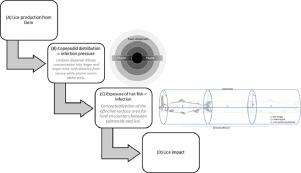Ecological Modelling ( IF 3.1 ) Pub Date : 2021-01-29 , DOI: 10.1016/j.ecolmodel.2021.109459 Alexander G Murray , Meadhbh Moriarty

|
Sea lice are marine ectoparasitic crustacea which limit the potential for sustainable salmon aquaculture due to risks of impacts on iconic wild salmon and sea trout. Control of the parasite on farms costs an estimated 9% of farm revenue. Sea lice develop through planktonic nauplii to copepodid stages which attach to, and mature on, salmonid hosts until females become ovigerous (egg laying) Impacts of lice on wild fish depend on their exposure to planktonic larval lice transported from salmon farms, which consists of (A) production of larval lice from ovigerous female lice on salmon farms, (B) local concentrations of planktonic larval lice infectious copepodids in adjacent waters, (C) rates of infestation of wild fish given these concentrations, and (D) impact on fish given this level of interaction. A model of this local exposure around salmon farms was developed. Production rates for nauplii as a function of the numbers of adult lice on salmon farms and maturation to copepodids (A) is well studied, as are impacts of infestation (D), with >0.75 lice per gram of host fish considered to present a high risk of mortality. Using existing assessments of infectious copepodid production (A) we develop a model of copepodid concentration (B) based on a simple kernel of copepodid distribution around farms; within this kernel the copepodids are assumed either to disperse evenly or to be transported in a concentrated plume, allowing comparison of the range of different concentration distributions. These distributions combine with a model of infestation (C) based on small-scale movements of copepodids in the immediate vicinity of a swimming fish. Fish swimming at intermediate velocities are most susceptible to infestation, as slow fish exhaust lice in their immediate vicinity while fast fish move on before lice copepodids can approach. These models are combined to create an assessment of the risk that concentrations can result in infestation of fish at levels considered to cause mortalities (D). The results can be used in combination with empirical assessments as a tool to link potential impacts on wild salmonids to aquaculture biomass and on-farm lice management in different environments in support of strategic aquaculture planning. Our modelling demonstrates the, often neglected, importance of fine-scale processes in sea lice infestation of salmonids.
中文翻译:

一个简单的建模工具,用于基于在时空上多个尺度上运行的过程,评估与野生鲑鱼上的鲑鱼养殖场的海虱的寄主和局部感染之间的相互作用
海虱是海洋寄生寄生性甲壳纲动物,由于其对标志性野生鲑鱼和海鳟的影响可能会限制鲑鱼可持续养殖的潜力。控制农场上的寄生虫的费用估计占农场收入的9%。海虱通过浮游无节幼体发育到附生阶段,并附着在鲑鱼宿主上并在其上成熟,直到雌鱼变卵(产卵)。虱子对野生鱼的影响取决于它们对鲑鱼养殖场运输的浮游幼虫的接触程度,其中包括( A)从鲑鱼养殖场的雌性虱子中产生幼虫虱子;(B)相邻水域中局部浮游性幼虫虱子感染性立足动物的局部浓度;(C)在这些浓度下野生鱼的侵染率;以及(D)对给定鱼类的影响这种互动水平。建立了鲑鱼养殖场周围这种局部暴露的模型。对无节幼体的生产率与鲑鱼养殖场中成虱的数量以及成足纲成熟的关系进行了很好的研究(A),而对侵染的影响(D)也得到了很好的研究,每克寄主鱼的虱子> 0.75虱被认为具有很高的虱子产量。死亡风险。使用对传染性两足动物生产的现有评估(A),我们基于农场周围两足动物分布的简单核心,开发了两足动物浓度(B)模型;在此内核中,立足类被认为可以均匀分散或在浓羽中运输,从而可以比较不同浓度分布的范围。这些分布与基于在游泳鱼附近的立足纲的小规模运动的侵染模型(C)结合在一起。中速游泳的鱼类最容易受到侵扰,因为缓慢的鱼类在其附近会排走虱子,而快速的鱼类会在虱子近足前接近之前继续前进。将这些模型结合起来,可以评估浓度可能导致鱼类死亡的风险(D)。结果可与经验评估结合使用,作为将对野生鲑鱼的潜在影响与水产养殖生物量和不同环境中的农场虱子管理联系起来的工具,以支持战略性水产养殖规划。我们的模型表明,在鲑鱼的海虱侵袭中,小规模生产过程的重要性(通常被忽略)。因为缓慢的鱼会在其附近排走虱子,而快速的鱼会在虱子近足类动物接近之前继续前进。将这些模型结合起来,可以评估浓度可能导致鱼类死亡的风险(D)。结果可与经验评估结合使用,作为将对野生鲑鱼的潜在影响与水产养殖生物量和不同环境中的农场虱子管理联系起来的工具,以支持战略性水产养殖规划。我们的模型表明,在鲑鱼的海虱侵袭中,小规模生产过程的重要性(通常被忽略)。因为缓慢的鱼会在其附近排走虱子,而快速的鱼会在虱子近足类动物接近之前继续前进。将这些模型结合起来,可以评估浓度可能导致鱼类死亡的风险(D)。结果可与经验评估结合使用,作为将对野生鲑鱼的潜在影响与水产养殖生物量和不同环境中的农场虱子管理联系起来的工具,以支持战略性水产养殖规划。我们的模型表明,在鲑鱼的海虱侵袭中,精细过程的重要性(通常被忽略)。结果可与经验评估结合使用,作为将对野生鲑鱼的潜在影响与水产养殖生物量和不同环境中的农场虱子管理联系起来的工具,以支持战略性水产养殖规划。我们的模型表明,在鲑鱼的海虱侵袭中,小规模生产过程的重要性(通常被忽略)。结果可与经验评估结合使用,作为将对野生鲑鱼的潜在影响与水产养殖生物量和不同环境中的农场虱子管理联系起来的工具,以支持战略性水产养殖规划。我们的模型表明,在鲑鱼的海虱侵袭中,小规模生产过程的重要性(通常被忽略)。



























 京公网安备 11010802027423号
京公网安备 11010802027423号